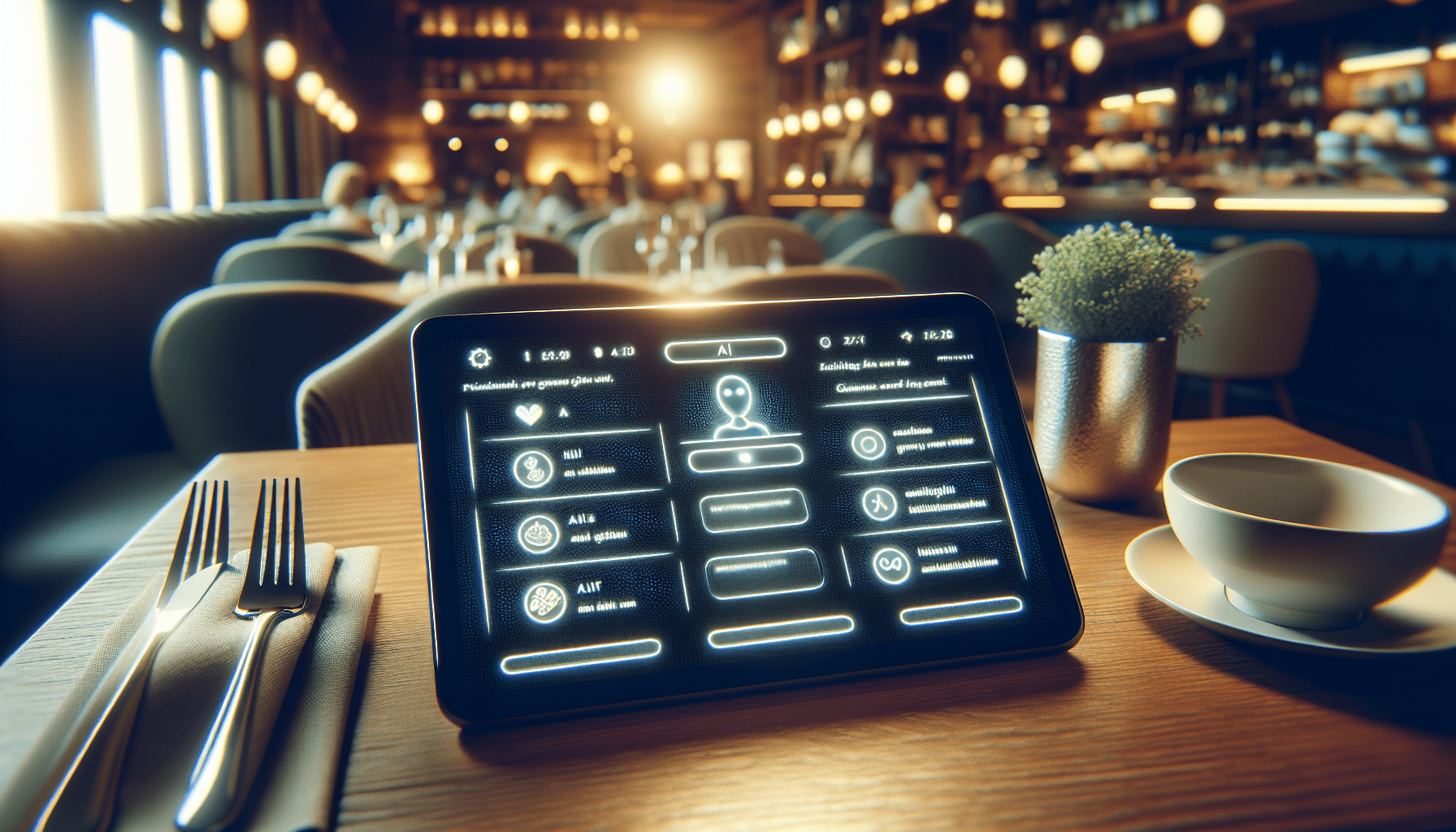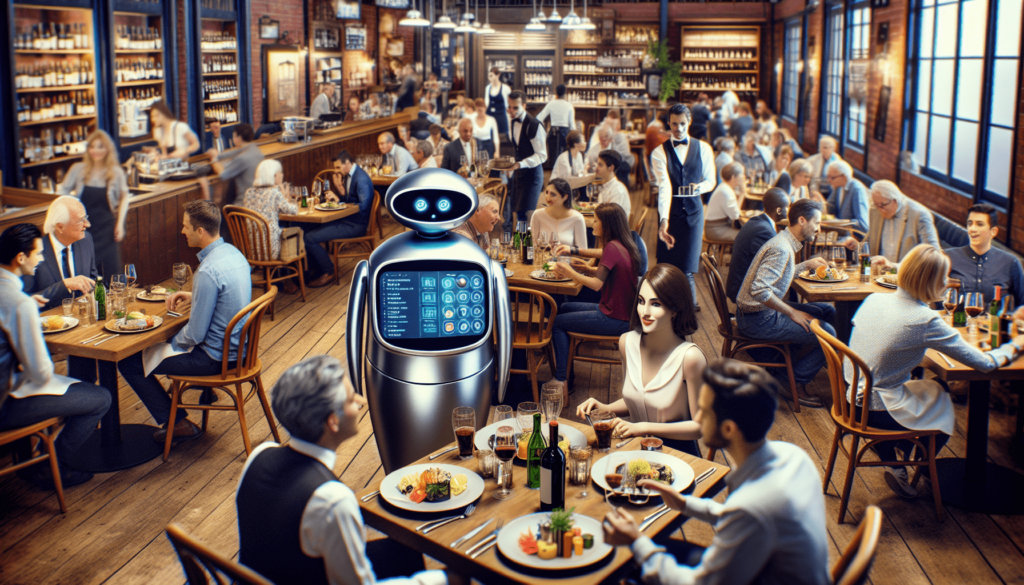Your cart is currently empty!
How AI Chatbots Can Revolutionize Customer Service For Local Restaurants

When it comes to customer service for local restaurants, AI chatbots have the potential to revolutionize the entire experience. In this article, you will discover how AI chatbots are changing the game for local eateries and enhancing customer interactions. Explore the ways in which these innovative technologies are streamlining processes and improving overall satisfaction for restaurant guests. Unlock the secrets behind how AI chatbots are reshaping the landscape of customer service in the food industry. Join us as we uncover the transformative power of AI chatbots for local restaurants.
How AI Chatbots Can Revolutionize Customer Service For Local Restaurants

Introduction to AI Chatbots in Customer Service
Imagine this scenario: You walk into a local restaurant for a quick lunch, and instead of waiting for a server to take your order, you are greeted by a friendly chatbot on a tablet at your table. This chatbot quickly guides you through the menu, recommends popular dishes based on your preferences, and even suggests wine pairings. Sounds futuristic, right? Well, with the advancements in artificial intelligence (AI) technology, this scenario is becoming a reality for many local restaurants.
AI chatbots are not just a trend; they are revolutionizing the way businesses interact with their customers, especially in the food and beverage industry. In this article, we will explore how AI chatbots can transform customer service for local restaurants, making dining experiences more personalized, efficient, and enjoyable.
Understanding AI Chatbots
What are AI Chatbots?
AI chatbots are computer programs powered by artificial intelligence that are designed to simulate conversation with human users, typically through text or voice-based interactions. These chatbots use natural language processing (NLP) and machine learning algorithms to understand and respond to user queries in a human-like manner.
Types of AI Chatbots
There are mainly two types of AI chatbots: rule-based chatbots and self-learning chatbots. Rule-based chatbots follow predefined rules and can provide scripted responses to specific queries. On the other hand, self-learning chatbots, also known as AI-powered chatbots, can learn from interactions with users and improve their responses over time.

Benefits of AI Chatbots for Local Restaurants
Enhanced Customer Experience
One of the primary benefits of using AI chatbots in local restaurants is the enhanced customer experience they offer. AI chatbots can provide personalized recommendations based on customer preferences, dietary restrictions, and past order history. By analyzing data in real-time, chatbots can offer tailored suggestions, making the dining experience more enjoyable for customers.
Increased Efficiency
AI chatbots can streamline the ordering process and reduce wait times for customers. With chatbots, customers can place orders, make reservations, and request assistance instantaneously, without the need to wait for a server. This not only increases operational efficiency for restaurants but also helps in managing peak hours and improving overall service quality.
24/7 Availability
Unlike human employees, AI chatbots are available 24/7 to assist customers with their queries and requests. This round-the-clock availability ensures that customers can get the information they need at any time, whether it’s during business hours or after closing. This constant support creates a seamless experience for customers and helps in building brand loyalty.
Cost-Effective Solution
Implementing AI chatbots in customer service can be a cost-effective solution for local restaurants. While the initial investment may require some resources, the long-term benefits outweigh the costs. AI chatbots can handle multiple customer inquiries simultaneously, reducing the need for additional staff during peak hours and ultimately saving on operational expenses.
Implementing AI Chatbots in Local Restaurants
Identifying Customer Needs
Before implementing AI chatbots in a local restaurant, it is essential to identify customer needs and pain points. Conducting surveys, analyzing customer feedback, and studying customer behavior can help in understanding what features and functionalities the chatbot should offer to enhance the dining experience.
Choosing the Right Platform
There are several platforms and tools available for building AI chatbots, ranging from DIY chatbot builders to customized solutions. It is crucial to choose a platform that aligns with the restaurant’s specific requirements, budget, and technical capabilities. Consider factors such as integration with existing systems, scalability, and ease of use when selecting a chatbot platform.
Training the Chatbot
Training the AI chatbot is a critical step in ensuring its effectiveness in customer service. Provide the chatbot with a comprehensive database of menu items, pricing information, special offers, and frequently asked questions. Continuous monitoring and feedback can help in refining the chatbot’s responses and improving its accuracy over time.
Testing and Optimization
Before launching the AI chatbot for customer interaction, it is essential to conduct thorough testing to identify any glitches or errors. Test the chatbot across different devices and platforms to ensure seamless functionality. Monitor user interactions and feedback to make necessary optimizations and improvements to the chatbot’s performance.
Real-World Examples of AI Chatbots in Local Restaurants
Domino’s Pizza
Domino’s Pizza, a global pizza chain, has integrated AI chatbots into its ordering system to enhance customer experience. Customers can place orders through the Domino’s chatbot on various messaging platforms, such as Facebook Messenger and WhatsApp. The chatbot provides personalized recommendations, order tracking, and seamless payment options, making the ordering process more convenient for customers.
Bear Robotics
Bear Robotics, a robotic company, has developed a server robot named “Penny” to assist restaurant staff in delivering food and beverages. Penny uses AI technology to navigate through the restaurant, interact with customers, and deliver orders to tables. This innovative solution combines AI chatbots with robotics to improve operational efficiency and customer service in local restaurants.
Wendy’s
Wendy’s, a popular fast-food chain, has deployed AI-powered chatbots for handling customer inquiries and feedback. Customers can interact with Wendy’s chatbot through messaging platforms to place orders, inquire about menu items, and provide feedback on their dining experience. The chatbot’s conversational interface and quick responses have enhanced customer engagement and satisfaction.
Challenges and Considerations
Data Privacy and Security
One of the key challenges of implementing AI chatbots in customer service is ensuring the privacy and security of customer data. Restaurants must comply with data protection regulations and implement robust security measures to safeguard sensitive information obtained through chatbot interactions.
Maintaining Human Touch
While AI chatbots offer efficiency and convenience, it is essential to maintain a human touch in customer interactions. Restaurants should strike a balance between automated responses and personalized communication to ensure that customers feel valued and understood.
Technical Support and Maintenance
AI chatbots require ongoing technical support and maintenance to ensure optimal performance. Restaurants should have a dedicated team to monitor the chatbot, address technical issues promptly, and update the chatbot’s database with new information regularly.
Future Trends in AI Chatbots for Local Restaurants
Voice Recognition Technology
Voice recognition technology is poised to revolutionize the way customers interact with AI chatbots in local restaurants. By enabling voice commands for ordering, reservations, and inquiries, restaurants can offer a hands-free and intuitive experience for customers.
Integration with IoT Devices
Integrating AI chatbots with Internet of Things (IoT) devices, such as smart speakers and wearables, can enhance customer engagement and accessibility. Customers can use voice commands to interact with the chatbot through IoT devices, making it easier to place orders and access information on the go.
Predictive Analytics
AI chatbots can leverage predictive analytics to anticipate customer preferences, behaviors, and trends. By analyzing past interactions and order history, chatbots can make personalized recommendations, suggest promotions, and enhance the overall customer experience.
Conclusion
AI chatbots have the potential to revolutionize customer service for local restaurants by providing personalized recommendations, increasing efficiency, and offering round-the-clock support to customers. By understanding the benefits, challenges, and best practices of implementing AI chatbots, local restaurants can enhance their service quality and stay ahead in the competitive food and beverage industry.
As technology continues to evolve, AI chatbots will play a pivotal role in shaping the future of customer service, offering innovative solutions to meet the changing needs and expectations of diners. Embracing AI chatbots can transform the dining experience for customers and drive growth and success for local restaurants in the digital age.